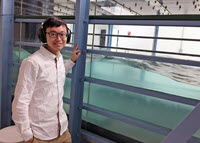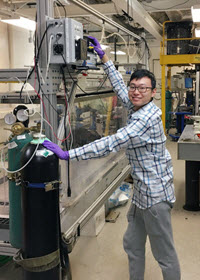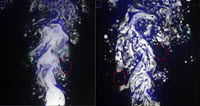
Xinzhi adjusts the laser optics for particle image velocimetry experiments. (Provided by Xinzhi Xue)
Laser light and high-speed cameras can help researchers observe the behavior of oil droplets within a laboratory-simulated oil plume and interpret how the oil subsequently may move through the water column. Xinzhi Xue uses lasers to non-invasively probe inside the oil plume and get a detailed look at the oil fragmentation process. “This knowledge is crucial to understanding oil spill impacts and recovery and is potentially relevant to geophysical and engineering applications ranging from fuel spray in aerospace propulsion systems to inkjet printing,” he said.
Xinzhi is a Ph.D. student in Johns Hopkins University’s Mechanical Engineering Program with focus on fluid mechanics and a GoMRI Scholarwith the Dispersion Research on Oil: Physics and Plankton Studies II (DROPPS II) consortium.
His Path

Xinzhi conducts his research in John Hopkins University’s wind tunnel and wave tank laboratory. (Provided by Xinzhi Xue)
Xinzhi’s parents, who are both engineers, sparked his interest in science. He conducted experiments with his father as a child, such as creating a paper pot capable of boiling water. Those small but fascinating scientific activities and his first trip on an airplane at age six were the greatest triggers for Xinzhi’s love of science. “It was rare at that time for kids to experience [a plane trip], because we live in a small town near the border between China and Russia,” he said. “That trip was a summation of all the [earlier] science experiments. I was amazed by everything.”

The laser set up in operation as former postdoc David Murphy and fellow Ph.D. student Kaushik Sampath monitor the results in the background. (Provided by Xinzhi Xue)
Xinzhi took an introductory fluid dynamics class as an exchange student at Purdue University and was amazed at the wide range of applications. He completed his undergraduate degree in mechanical engineering at China’s Harbin Institute of Technology and applied to the Ph.D. program in fluid dynamics at Johns Hopkins University where Dr. Joseph Katz is a co-Principle Investigator of a Deepwater Horizon oil spill study. Xinzhi was eager to apply his studies to a real world problem with which he personally connected. “My grandparents and parents were in the petroleum industry. Eventually life brought me petroleum-related research,” he said. “It was devastating to see the Gulf of Mexico get tremendously oil polluted during [Deepwater Horizon], not to mention the platform workers who were killed in the explosion. I felt a sense of responsibility as a researcher and engineer to make better and safer designs and provide data for predicting oil fate so responders could make well-informed decisions.”
His Work

Xinzhi analyses data from his plume experiments in his office at Johns Hopkins University. (Provided by Xinzhi Xue)
Subsurface oil blowouts create turbulent oil plumes that quickly break up into droplets, which either rise to the surface or become trapped in the water column. Xinzhi’s previous experiments conducted alongside Dr. David Murphy and Kaushik Sampath found that when a crude oil plume interacts with the surrounding water moving around its escape point, the plume that forms consists of whirlpool-like flows that significantly affect how oil droplets are distributed. When mixed with chemical dispersant, crude oil plumes generate dramatically smaller droplets that are more easily entrained in large-scale vortex structures. His current research focuses on better understanding the mechanisms driving plume fragmentation.
Xinzhi illuminates the oil plume with a laser and then uses florescent and particle image velocimetry to observe the distribution of the plume’s oil phase and calculate the flow velocity field inside and outside the plume. When analyzing liquid-liquid flows (such as crude oil in sea water), optical diagnostics are limited when the two liquids’ refractive indexes (the extent that light bends when entering a material) are mismatched and cause optical distortions. Xinzhi avoids these limitations using surrogates for oil and water that have matching refractive indices. This method allows him to observe the center of the plume and quantify the oil fragmentation process in detail.

Simultaneous images of the plume depict a) oil phase fluorescence, b) velocity and vorticity distributions, and c) overlaid distributions of oil phase (white) and the strain rate magnitude. (Provided by Xinzhi Xue)
He has found that as oil plumes develop, they often entrain ambient water, which then becomes encapsulated inside oil ligaments and forms hollow, water-filled oil droplets that his team refers to as “Russian doll” droplets. These multilayer droplets often act significantly different than simple droplets because their changed buoyancy affects their movement through the water. Xinzhi said that the subsequent transport of multilayer droplets is distinct from the surrounding oil and that dispersion models should account for this phenomenon. “The presence of Russian doll droplets can change the surface area between oil and water, making them potentially important when considering the gas diffusion and heat transfer aspect of oil droplets in the subsurface environment,” he explained.
Xinzhi hopes that his previous research on dispersant and oil plumes can help improve concentration guidelines for future dispersant deployments. His work could also provide experiment data and dynamics for liquid atomization, droplet breakup, and collision statistics, which could help future responders better understand oil breakup and how previously unexplored phenomenon, such as “Russian doll” droplets, affect the oil fragmentation process.
His Learning

Xinzhi operates the towing tank carriage. (Provided by Xinzhi Xue)
The most valuable lesson Xinzhi learned from his advisor is the importance of doubt. When presenting Katz with his experiment plans, Xinzhi faced questions from Katz about the logic behind his plan and its potential faults. Although the process was often stressful and frustrating, it taught him how to improve as a researcher. “It is that spirit of doubt and curiosity that leads us to concrete facts and drives people closer to the truth,” he said. “I now always ask myself those same probing questions.”
One of Xinzhi’s favorite memories is when he showed Katz the jet fragmentation data he collected using a high-magnification high-speed camera. It was the first detailed quantitative data of the plume’s center and best representation of the Russian doll droplets. Katz’s first reaction was to praise the beauty of the images before addressing their scientific aspects. Xinzhi explained, “Nothing compares with nature revealing its beauty before your eyes for the first time. It gave me a great appreciation for my work after all those late nights in the lab.”
His Future

An overlaid image depicts the distribution of oil phase (white) and velocity vector (blue). Red circles identify significant entrainment inside the larger coherent structure (green circles). (Provided by Xinzhi Xue)
Xinzhi hopes to apply the technology and management skills he gained through his Ph.D. and GoMRI research to a position in academia, consulting, or industry. He wants to inspire the next generation of scientists the way that science and engineering inspired him. Xinzhi related his aspirations to musical conductor Benjamin Zander’s theory that a conductor’s power comes from his ability to make others powerful and put a shine in their eyes. “I’ve seen Hopkins professors’ shining eyes when talking about their research,” he said. “I hope I’ll also be someone who has shining eyes and makes other peoples’ eyes light up.”
The GoMRI community embraces bright and dedicated students like Xinzhi Xue and their important contributions. The GoMRI Scholars Program recognizes graduate students whose work focuses on GoMRI-funded projects and builds community for the next generation of ocean science professionals. Visit the DROPPS website to learn more about their work.
************
The Gulf of Mexico Research Initiative (GoMRI) is a 10-year independent research program established to study the effect, and the potential associated impact, of hydrocarbon releases on the environment and public health, as well as to develop improved spill mitigation, oil detection, characterization and remediation technologies. An independent and academic 20-member Research Board makes the funding and research direction decisions to ensure the intellectual quality, effectiveness and academic independence of the GoMRI research. All research data, findings and publications will be made publicly available. The program was established through a $500 million financial commitment from BP. For more information, visit http://gulfresearchinitiative.org/.
© Copyright 2010- 2017 Gulf of Mexico Research Initiative (GoMRI) – All Rights Reserved. Redistribution is encouraged with acknowledgement to the Gulf of Mexico Research Initiative (GoMRI). Please credit images and/or videos as done in each article. Questions? Contact web-content editor Nilde “Maggie” Dannreuther, Northern Gulf Institute, Mississippi State University (maggied@ngi.msstate.edu).
